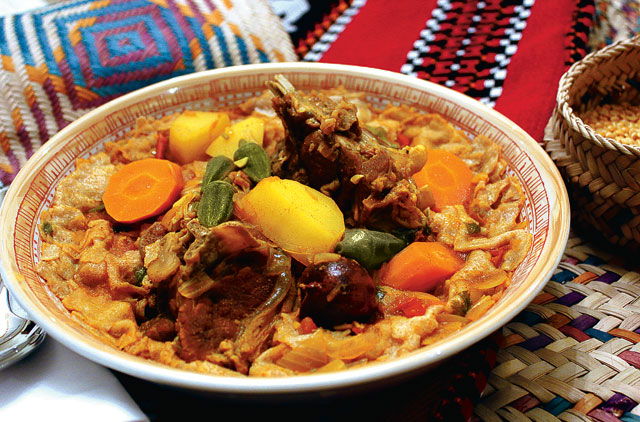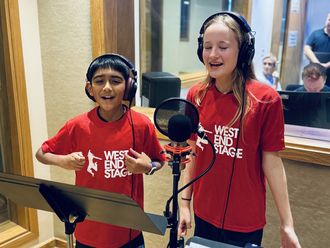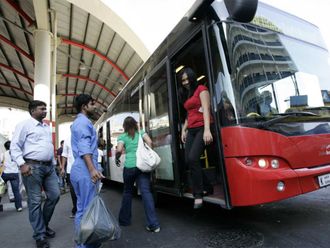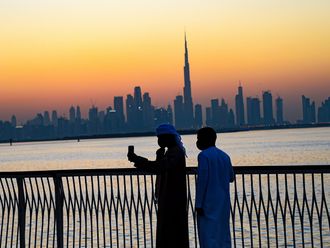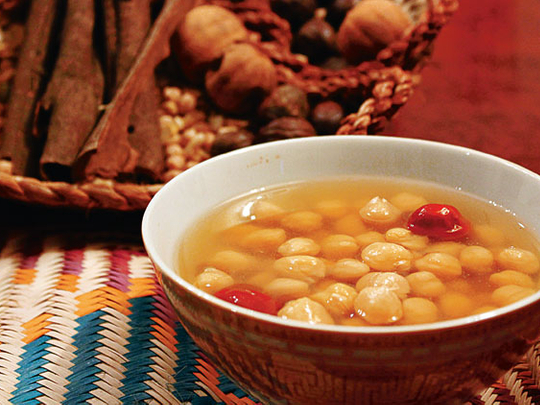
It is conveniently classified as Arab or Middle Eastern and often confused with Lebanese or Levantine. Even veteran expatriates are guilty of enumerating hummus, tabbouleh and shawarma as staples when they are clearly not. And until recently, it was almost impossible to find a restaurant menu listing local flavours.
Admittedly, Emirati food is not as popular as many of its regional contemporaries, but the UAE does have a cuisine of its own, and as is the norm, it is underpinned by factors such as climate, trade, availability of ingredients, dietary laws, food preservation and cultural traditions.
Before modern farming techniques made their way into the country, the UAE’s harsh desert conditions and abundant coastlines meant that most meals were based on meat and dairy products or the bounties of the sea. Fowl included chicken and the houbara bustard, and meat simply meant goat. Meat from the camel was — and still is — reserved for special occasions, given the animal’s multiple uses. When available, vegetables were incorporated into meat dishes.
Natural inclination
While saffron, cardamom, cinnamon, turmeric and thyme formed core flavourings, leaves from indigenous trees such as the ghaf were used to stuff small birds and to provide additional flavour.
Fish has always figured prominently and is prepared in a variety of ways: grilled, fried or cooked with rice. Traditional methods of preserving include salt curing or sun drying. Christopher Baker, Executive Chef, Qasr Al Sarab Desert Resort by Anantara, summarises this evolution. “Food represents the history of a country, and Emirati food is no different. The use of the camel for its milk and meat, the beautiful Liwa dates and the spices traded over the years make this food richer than most people think,” says Baker. He is fiercely proud of featuring Emirati foods in the resort’s room service menu, and a Bedouin menu with special national dishes.
“For me, food is about ingredients. I particularly love mashwi made with local fish and dates, which have many uses. Camel milk has a great taste and is very good for you — my favourites are healthy date smoothies and ice creams made with camel milk,” he says. “Camel meat is great when it is cooked correctly. Most people do not know how to cook it and that leads to people thinking it is not a nice meat.”
Key influences
Of course, Emiratis don’t subsist on camel milk and meat; they never have. Against the backdrop of a hostile climate, tough living conditions and the grim poverty of the pre-oil era, most dishes were stewed in a single pot. Rice was introduced only when trade commenced.
The two greatest influences on Emirati cuisine stemmed from trade with India and Iran. “Take Iranian food and Indian food, put them in a blender, and the result is Emirati cuisine,” declares Hashem Al Marzouqi of Al Fanar in Dubai Festival City, the first authentic Emirati restaurant in the country. The passionate owner painstakingly identifies every influence in the dishes at his restaurant as a guide for initiates. For instance, anyone from Kerala or Goa will quickly recognise koftat samak as a fish cutlet, while the berianis are redolent of erstwhile Persia.
“Three things that make our food truly ours are loomi, baharat and zaatar,” Al Marzouqi points out, referring to the dried preserved lemon, spice mixture and native thyme that are essential ingredients in Emirati cooking.
Al Marzouqi is a self-appointed global ambassador of his cuisine, and Al Fanar serves a variety of special dishes that you would be hard-pressed to find elsewhere. Specialities include Muhammar bil dibs — rice cooked with a date extract — and Aysh Mohamar ma Samak Magli, a variation of pan-fried fish. Balaleet is almost a pasta — a sweet, thin flavoured noodle served with scrambled eggs. Jasheed is flaky spiced shark meat served with white rice.
The M words
One of the most popular ways of preparing meat is a localised version of mandi. This ancient technique involves barbecuing meat in a pit in the earth — often called coal hole — that is covered as the meat cooks slowly underground. Another technique is mathbi in which seasoned meat is grilled on flat stones placed atop burning embers. A third technique, madghut, involves cooking meat under pressurised steam.
Grilled seafood is called mashwi, but fish is also grilled in the masghouf style, where it is first cut open to create a symmetrical circle, marinated in a variable mixture of oil, salt, tamarind and turmeric, and then slow grilled on an open flame.
Madrooba is salt-cured fish seasoned with spices, and as it cooks in a pot, flour is slowly added to thicken the sauce. The dish is usually served with a generous topping of ghee, or clarified butter.
Perhaps the most popular of all Emirati meals is machboos or majbous — a group of rice dishes with a variety of meat or seafood, vegetables and spices arranged in layers and slow cooked to perfection in an oven or coal hole. Each variation has a unique flavour. Although pre-mixed machbous spices are now easily available and almost halve preparation time, nothing tastes as good as the traditional mix.
If machboos is a staple, mahshi is special. Made to mark special occasions and celebrations, this slow-roasted lamb, stuffed with rice, raisins, onions, eggs, nuts and spices, is considered a tribute to honoured guests.
Breads and breakfast
A traditional Emirati breakfast features a variety of flat breads served with cheese, date syrup or eggs. It is said that the Bedouins once baked their breads on hot stones in the desert, but despite modern technology, everyday bread-making still features rustic gadgets such as curved plates and cast-iron utensils.
Rigag is a thin bread made of a soft flour paste in a pan. Resembling a French crêpe, it is served with either meat or white cheese. Rigag involves baking soft unleavened dough on a hot iron plate, with toppings ranging from ghee and butter to meat gravy. Muhala is similar to rigag, except the topping is an egg spread and it is eaten with sugar. The flat yeast bread, Chabab, is a risen dough that is either pan-fried or baked in a traditional oven called the tabi.
Soups and stews
In local parlance, saloonas are stews or hearty soups that serve as full meals. This traditional Bedouin dish features meat cooked with onions, spices, tomato paste and vegetables such as courgettes, eggplant, pepper, tomato or okra.
Thareed is a stew of chicken or lamb and vegetables served over rigag bread. Harees is extremely popular during special occasions such as Ramadan, Eid or weddings. Meat, cracked wheat and water are boiled and blended together into a thick paste before it is cooked in a coal hole, resulting in something very similar to Indian haleem.
Desserts of the desert
Not surprisingly, a lot of Emirati sweets involves dates, date pastes and preserved dates. Batheetha is a crumble of sorts, with wheat flour, butter and ripe dates, while rangeenah is a dish of dates baked with a butter crust topping. Luqaimat or Lokemat are deep-fried dough balls that are traditionally served with date syrup. Khabeesa, is a crumbly desert with molasses, roasted flour and cashew nuts.
Khanfaroosh is wheat or rice flour, egg, sugar, yeast, cardamom, saffron and rose water, fried in ghee. Aseedat bobar, a heavy red pumpkin custard, is traditionally served during Ramadan.
“More Emirati restaurants in the UAE would help showcase the rich history of the Emirates,” says Baker. Michelin-star chef Vineet Bhatia has gone on record to say “Emirati restaurants are the only element missing from the UAE’s F&B portfolio”.
Change seems to be in the offing. Hashem Al Marzouqi has several concepts up his sleeve, and his hands are full with intriguing plans, but it will be a while until Emirati food is made available on a larger scale.
A taste of the UAE
Everyone wants to experience Emirati food, but where is it available?
Abu Dhabi serves up fine-dining Emirati cuisine at the Mezlai restaurant in Emirates Palace in splendid style. Resident guests can enjoy specialities at the Qasr Al Sarab Desert Resort by Anantara. Also in the capital, Al Dhafra restaurant at Al Mina is famed for serving a great range of traditional Emirati sweets.
Al Fanar is located at the waterfront in Dubai Festival City and recreates old Dubai with authentic dishes to boot. Al Dawaar at Hyatt Regency Dubai serves a Friday buffet that often features Emirati dishes. The Heritage Village at Dubai’s Bastakiya has cultural meals that evoke the dining traditions of the UAE.
Camel burgers are available at Local House restaurant in Bastakiya, and its branch in The Walk, Jumeirah Beach Residence. They also feature in Switch’s menu at the Dubai Mall. Camel meat is occasionally sold at Carrefour hypermarkets.
Baharat at home: Tess Mallos’ version from ‘The Complete Middle East Cookbook’
½ cup of black peppercorns and paprika
¼ cup of coriander seeds, cassia bark and cloves
1/3 cup of cumin seeds
2tsp of cardamom seeds ground together.
Add 4 grated nutmegs.


